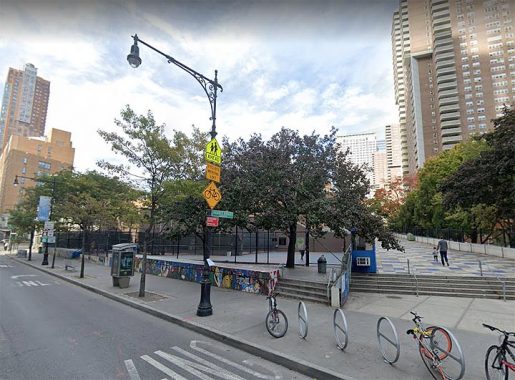Today I’m showing an extinct variety of castiron lamp that could very occasionally be found on NYC streets. Oddly this post does not appear in either the Landmarks Preservation Commission’s 1994 pamphlet, Inventory of Historic Street Lamps in the City of New York, listing every lamppost/signal that had been given LPC protection up to that point; or an earlier publication, The System Electric Companies: Photographs of Street Lighting Equipment as of 1934. However, Bob Mulero does list it in his 2017 book The History and Design of New York City Streetlights, in which it’s identified as a Type 8.
While this post, seen here at 197 Chambers Street between Washington and West Streets in 1940, found its way to the former Washington Market area on the lower West Side — which today is dominated by Washington Park and the Independence Plaza housing project — it also had a bastion on York Avenue on the upper East Side, renamed from Avenue A in 1920 for World War I hero sharpshooter Sergeant Alvin York.
There are no examples left of this very unusual NYC lamppost, with elaborate iron scrollwork and a pyramidical base (invisible here behind the sign). The lamp fixture here retains its original position at the end of a long wire. This would be impractical these days and indeed, it was not retained where the Type 8 was used on York Avenue. Moreover the Type 8 has not been reproduced by Spring City, the Pennsylvania company that has reproduced many of NYC’s older lamppost styles. I imagine it would be just too complicated!

What had been 197 Chambers Street looks like this these days. The old wholesale market buildings were torn down in the 1970s after the first world Trade Center was built just south of here, and by the early 1980s Washington Park and Independence Plaza (seen right background) had been built. Type 24M “Corvington” lampposts were installed in the 1990s.
A sign on the lamp reads “Frederick Douglass Landing.”
On September 3, 1838, orator, author and abolitionist Douglass successfully escaped slavemaster William Freeland by boarding a train to Havre de Grace, Maryland. He was dressed in a sailor‘s uniform and carried identification papers which he had obtained from a free black seaman. He crossed the Susquehanna River by ferry at Havre de Grace, then continued by train to Wilmington, Delaware. From there he went by steamboat to “Quaker City” (Philadelphia, Pennsylvania) and continued to the safe house of abolitionist David Ruggles in New York; the whole journey took less than 24 hours. wikipedia
Frederick Douglass later wrote of his arrival in New York:
“I have often been asked, how I felt when first I found myself on free soil. And my readers may share the same curiosity. There is scarcely anything in my experience about which I could not give a more satisfactory answer. A new world had opened upon me. If life is more than breath, and the ‘quick round of blood,’ I lived more in one day than in a year of my slave life. It was a time of joyous excitement which words can but tamely describe. In a letter written to a friend soon after reaching New York, I said: ‘I felt as one might feel upon escape from a den of hungry lions.’ Anguish and grief, like darkness and rain, may be depicted; but gladness and joy, like the rainbow, defy the skill of pen or pencil.”
Check out the ForgottenBook, take a look at the gift shop, and as always, “comment…as you see fit.”
5/8/20


1 comment
It’s the lamppost from the board game ‘Mouse Trap!’